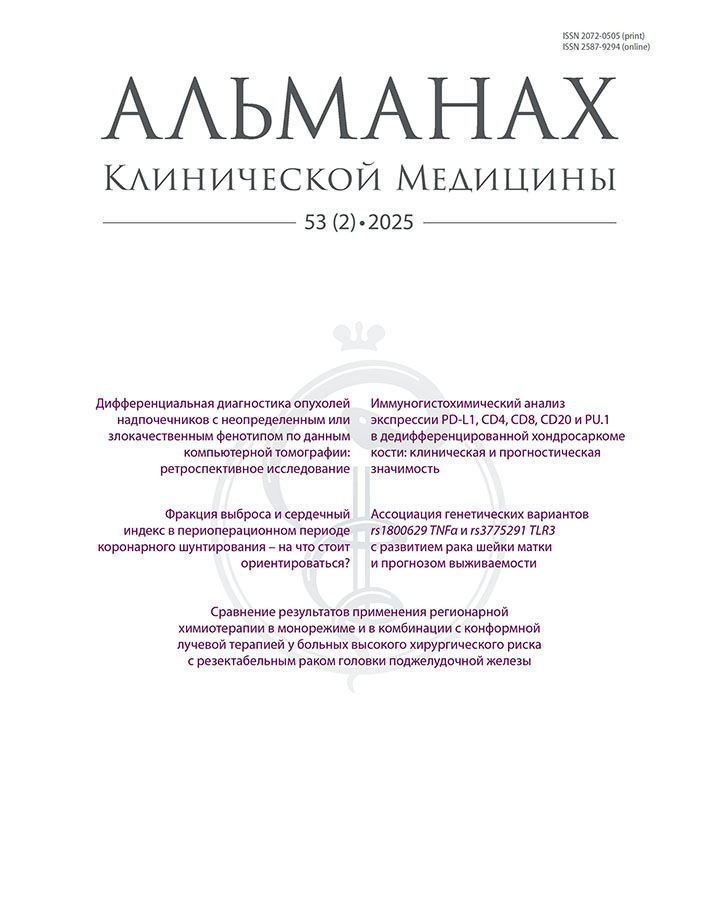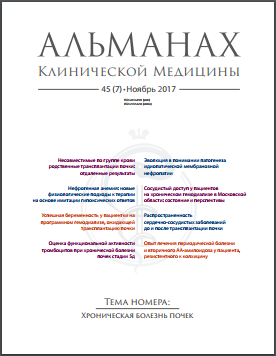Опыт успешного лечения периодической болезни и вторичного АА-амилоидоза у пациента, резистентного к колхицину
- Авторы: Рамеев В.В.1, Богданова М.В.2, Козловская Л.В.1, Мухин Н.А.1,2
-
Учреждения:
- ФГАОУ ВО Первый Московский государственный медицинский университет имени И.М. Сеченова Минздрава России
- ФГБОУ ВО «Московский государственный университет имени М.В. Ломоносова»
- Выпуск: Том 45, № 7 (2017)
- Страницы: 605-615
- Раздел: КЛИНИЧЕСКИЕ НАБЛЮДЕНИЯ
- URL: https://almclinmed.ru/jour/article/view/646
- DOI: https://doi.org/10.18786/2072-0505-2017-45-7-605-615
- ID: 646
Цитировать
Полный текст
Аннотация
В статье на примере клинического наблюдения колхицинрезистентной периодической болезни показаны современные возможности эффективного лечения периодической болезни как аутовоспалительного заболевания. Представлен актуальный взгляд на теорию аутовоспаления, молекулярные механизмы его реализации при периодической болезни. На основе данных литературы с привлечением результатов собственных исследований рассмотрены подходы к оценке активности аутовоспаления и мониторирования эффективности лечения. Показано клиническое значение современного маркера активности нейтрофильного аутовоспаления S100A12.
Ключевые слова
Об авторах
В. В. Рамеев
ФГАОУ ВО Первый Московский государственный медицинский университет имени И.М. Сеченова Минздрава России
Автор, ответственный за переписку.
Email: vvrameev@mail.ru
канд. мед. наук, доцент
кафедра внутренних, профессиональных болезней и пульмонологии
медико-профилактический факультет
119435, г. Москва, ул. Россолимо, 11/5
Тел.: +7 (910) 493 61 38
119991, г. Москва, ул. Трубецкая, 8/2
РоссияМ. В. Богданова
ФГБОУ ВО «Московский государственный университет имени М.В. Ломоносова»
Email: fake@neicon.ru
канд. мед. наук, ассистен
кафедра внутренних болезней
факультет фундаментальной медицины
119991, г. Москва, Ленинские горы, 1
РоссияЛ. В. Козловская
ФГАОУ ВО Первый Московский государственный медицинский университет имени И.М. Сеченова Минздрава России
Email: fake@neicon.ru
д-р мед. наук, профессор, гл. науч. сотр.,
кафедра внутренних, профессиональных болезней и пульмонологии
медико-профилактический факультет
119991, г. Москва, ул. Трубецкая, 8/2
РоссияН. А. Мухин
ФГАОУ ВО Первый Московский государственный медицинский университет имени И.М. Сеченова Минздрава России; ФГБОУ ВО «Московский государственный университет имени М.В. Ломоносова»
Email: fake@neicon.ru
д-р мед. наук, профессор, академик РАН, заведующий
кафедра внутренних, профессиональных болезней и пульмонологии
медико-профилактический факультет
заведующий
кафедра внутренних болезней
факультет фундаментальной медицины
119991, г. Москва, ул. Трубецкая, 8/2
119991, г. Москва, Ленинские горы, 1
РоссияСписок литературы
- Siegal S. Benign paroxysmal peritonitis. Ann Intern Med. 1945;23(1):1–21. doi: 10.7326/0003- 4819-23-1-1
- Виноградова ОМ. Периодическая болезнь. М.: Медицина; 1973. 200 с.
- Touitou I, Lesage S, McDermott M, Cuisset L, Hoffman H, Dode C, Shoham N, Aganna E, Hugot JP, Wise C, Waterham H, Pugnere D, Demaille J, Sarrauste de Menthiere C. Infevers: an evolving mutation database for auto-inflammatory syndromes. Hum Mutat. 2004;24(3): 194–8. doi: 10.1002/humu.20080.
- Milhavet F, Cuisset L, Hoffman HM, Slim R, El-Shanti H, Aksentijevich I, Lesage S, Waterham H, Wise C, Sarrauste de Menthiere C, Touitou I. The infevers autoinflammatory mutation online registry: update with new genes and functions. Hum Mutat. 2008;29(6):803–8. doi: 10.1002/humu.20720.
- Ancient missense mutations in a new member of the RoRet gene family are likely to cause familial Mediterranean fever. The International FMF Consortium. Cell. 1997;90(4): 797–807. doi: https://doi.org/10.1016/S0092- 8674(00)80539-5.
- Chae JJ, Wood G, Richard K, Jaffe H, Colburn NT, Masters SL, Gumucio DL, Shoham NG, Kastner DL. The familial Mediterranean fever protein, pyrin, is cleaved by caspase-1 and activates NF-kappaB through its N-terminal fragment. Blood. 2008;112(5):1794–803. doi: 10.1182/blood-2008-01-134932.
- Mansfield E, Chae JJ, Komarow HD, Brotz TM, Frucht DM, Aksentijevich I, Kastner DL. The familial Mediterranean fever protein, pyrin, associates with microtubules and colocalizes with actin filaments. Blood. 2001;98(3): 851–9. doi: https://doi.org/10.1182/blood. V98.3.851.
- Goldfinger SE. Colchicine for familial Mediterranean fever. N Engl J Med. 1972;287(25):1302. doi: 10.1056/NEJM197212212872514.
- de Jesus AA, Canna SW, Liu Y, Goldbach-Mansky R. Molecular mechanisms in genetically defined autoinflammatory diseases: disorders of amplified danger signaling. Annu Rev Immunol. 2015;33:823–74. doi: 10.1146/annurev-immunol-032414-112227.
- Yu JW, Wu J, Zhang Z, Datta P, Ibrahimi I, Taniguchi S, Sagara J, Fernandes-Alnemri T, Alnemri ES. Cryopyrin and pyrin activate caspase-1, but not NF-kappaB, via ASC oligomerization. Cell Death Differ. 2006;13(2):236–49. doi: 10.1038/sj.cdd.4401734.
- Chae JJ, Wood G, Masters SL, Richard K, Park G, Smith BJ, Kastner DL. The B30.2 domain of pyrin, the familial Mediterranean fever protein, interacts directly with caspase-1 to modulate IL-1beta production. Proc Natl Acad Sci U S A. 2006;103(26):9982–7. doi: 10.1073/ pnas.0602081103.
- Papin S, Cuenin S, Agostini L, Martinon F, Werner S, Beer HD, Grütter C, Grütter M, Tschopp J. The SPRY domain of Pyrin, mutated in familial Mediterranean fever patients, interacts with inflammasome components and inhibits proIL-1beta processing. Cell Death Differ. 2007;14(8):1457–66. doi: 10.1038/ sj.cdd.4402142.
- Тареев ЕМ, Виноградова ОМ, Кочубей ЛН, Чегаева ТВ. Подходы к лечению амилоидоза. Урология и нефрология. 1983;(6):56–63.
- Виноградова ОМ, Кочубей ЛН, Чегаева ТВ. Современная тактика лечения амилоидоза. Терапевтический архив. 1990;62(2):139–45.
- Goldstein RC, Schwabe AD. Prophylactic colchicine therapy in familial Mediterranean fever. A controlled, double-blind study. Ann Intern Med. 1974;81(6):792-4. doi: 10.7326/0003- 4819-81-6-792.
- Simsek H, Kadayifci A, Kirazli S. Anti-neutrophil cytoplasmic antibodies in familial Mediterranean fever. Clin Rheumatol. 1996;15(2):216–8.
- Zemer D, Revach M, Pras M, Modan B, Schor S, Sohar E, Gafni J. A controlled trial of colchicine in preventing attacks of familial mediterranean fever. N Engl J Med. 1974;291(18):932-4. doi: 10.1056/NEJM197410312911803.
- Livneh A, Zemer D, Langevitz P, Shemer J, Sohar E, Pras M. Colchicine in the treatment of AA and AL amyloidosis. Semin Arthritis Rheum. 1993;23(3):206–14.
- Heath DA, Palmer JS, Aurbach GD. The hypocalcemic action of colchicine. Endocrinology. 1972;90(6):1589-93. doi: 10.1210/endo-90-6- 1589.
- Nimoityn P, Lasker N, Soriano RZ. Detection of urinary amyloid in familial Mediterranean fever. Br Med J. 1976;2(6030):284.
- Ben-Chetrit E, Levy M. Does the lack of the P-glycoprotein efflux pump in neutrophils explain the efficacy of colchicine in familial Mediterranean fever and other inflammatory diseases? Med Hypotheses. 1998;51(5): 377-80. doi: http://dx.doi.org/10.1016/S0306- 9877(98)90031-7.
- Lagrue G, Koeger AC, Benaym JC, Sobel A. Colchicine treatment of renal amylosis in familial paroxysmal polyserositis. Ann Med Interne (Paris). 1981;132(7):496–500.
- Peters RS, Lehman TJ, Schwabe AD. Colchicine use for familial Mediterranean fever. Observations associated with long-term treatment. West J Med. 1983;138(1):43–6.
- Козловская ЛВ. Амилоидоз. Терапевтический архив. 1998;60(6):62–70.
- Belkhir R, Moulonguet-Doleris L, Hachulla E, Prinseau J, Baglin A, Hanslik T. Treatment of familial Mediterranean fever with anakinra. Ann Intern Med. 2007;146(11):825–6. doi: 10.7326/0003-4819-146-11-200706050-00023.
- Pras E, Livneh A, Balow JE Jr, Pras E, Kastner DL, Pras M, Langevitz P. Clinical differences between North African and Iraqi Jews with familial Mediterranean fever. Am J Med Genet. 1998;75(2):216–9. doi: 10.1002/ (SICI)1096-8628(19980113)75:23.0.CO;2-R.
- Mor A, Shinar Y, Zaks N, Langevitz P, Chetrit A, Shtrasburg S, Rabinovitz E, Livneh A. Evaluation of disease severity in familial Mediterranean fever. Semin Arthritis Rheum. 2005;35(1): 57–64. doi: 10.1016/j.semarthrit.2005.02.002.
- Piram M, Frenkel J, Gattorno M, Ozen S, Lachmann HJ, Goldbach-Mansky R, Hentgen V, Neven B, Stojanovic KS, Simon A, Kuemmerle-Deschner J, Hoffman H, Stojanov S, Duquesne A, Pillet P, Martini A, Pouchot J, Koné-Paut I; EUROFEVER and EUROTRAPS networks. A preliminary score for the assessment of disease activity in hereditary recurrent fevers: results from the AIDAI (Auto-Inflammatory Diseases Activity Index) Consensus Conference. Ann Rheum Dis. 2011;70(2):309–14. doi: 10.1136/ard.2010.132613.
- Piram M, Koné-Paut I, Lachmann HJ, Frenkel J, Ozen S, Kuemmerle-Deschner J, Stojanov S, Simon A, Finetti M, Sormani MP, Martini A, Gattorno M, Ruperto N; EUROFEVER, EUROTRAPS and the Paediatric Rheumatology International Trials Organisation (PRINTO) networks. Validation of the auto-inflammatory diseases activity index (AIDAI) for hereditary recurrent fever syndromes. Ann Rheum Dis. 2014;73(12):2168–73. doi: 10.1136/annrheumdis-2013-203666.
- Forget P, Khalifa C, Defour JP, Latinne D, Van Pel MC, De Kock M. What is the normal value of the neutrophil-to-lymphocyte ratio? BMC Res Notes. 2017;10(1):12. doi: 10.1186/s13104- 016-2335-5.
- Ahsen A, Ulu MS, Yuksel S, Demir K, Uysal M, Erdogan M, Acarturk G. As a new inflammatory marker for familial Mediterranean fever: neutrophil-to-lymphocyte ratio. Inflammation. 2013;36(6):1357–62. doi: 10.1007/s10753-013- 9675-2.
- Lachmann HJ, Goodman HJ, Gilbertson JA, Gallimore JR, Sabin CA, Gillmore JD, Hawkins PN. Natural history and outcome in systemic AA amyloidosis. N Engl J Med. 2007;356(23):2361- 71. doi: 10.1056/NEJMoa070265.
- Aganna E, Hawkins PN, Ozen S, Pettersson T, Bybee A, McKee SA, Lachmann HJ, Karenko L, Ranki A, Bakkaloglu A, Besbas N, Topaloglu R, Hoffman HM, Hitman GA, Woo P, McDermott MF. Allelic variants in genes associated with hereditary periodic fever syndromes as susceptibility factors for reactive systemic AA amyloidosis. Genes Immun. 2004;5(4):289–93. doi: 10.1038/sj.gene.6364070.
- Cantarini L, Rigante D, Lucherini OM, Cimaz R, Laghi Pasini F, Baldari CT, Benucci M, Simonini G, Di Sabatino V, Brizi MG, Galeazzi M. Role of etanercept in the treatment of tumor necrosis factor receptor-associated periodic syndrome: personal experience and review of the literature. Int J Immunopathol Pharmacol. 2010;23(3):701–7. doi: 10.1177/039463201002300303.
- Foell D, Wittkowski H, Roth J. Mechanisms of disease: a 'DAMP' view of inflammatory arthritis. Nat Clin Pract Rheumatol. 2007;3(7): 382–90. doi: 10.1038/ncprheum0531.
- Lotze MT, Tracey KJ. High-mobility group box 1 protein (HMGB1): nuclear weapon in the immune arsenal. Nat Rev Immunol. 2005;5(4): 331–42. doi: 10.1038/nri1594.
- Yan WX, Armishaw C, Goyette J, Yang Z, Cai H, Alewood P, Geczy CL. Mast cell and monocyte recruitment by S100A12 and its hinge domain. J Biol Chem. 2008;283(19):13035–43. doi: 10.1074/jbc.M710388200.
- Yang H, Reinherz EL. CD2BP1 modulates CD2-dependent T cell activation via linkage to protein tyrosine phosphatase (PTP)-PEST. J Immunol. 2006;176(10):5898–907. doi: https:// doi.org/10.4049/jimmunol.176.10.5898.
- Newton RA, Hogg N. The human S100 protein MRP-14 is a novel activator of the beta 2 integrin Mac-1 on neutrophils. J Immunol. 1998;160(3):1427–35.
- Foell D, Wittkowski H, Hammerschmidt I, Wulffraat N, Schmeling H, Frosch M, Horneff G, Kuis W, Sorg C, Roth J. Monitoring neutrophil activation in juvenile rheumatoid arthritis by S100A12 serum concentrations. Arthritis Rheum. 2004;50(4): 1286–95. doi: 10.1002/art.20125.
- Kuemmerle-Deschner JB, Tyrrell PN, Koetter I, Wittkowski H, Bialkowski A, Tzaribachev N, Lohse P, Koitchev A, Deuter C, Foell D, Benseler SM. Efficacy and safety of anakinra therapy in pediatric and adult patients with the autoinflammatory Muckle-Wells syndrome. Arthritis Rheum. 2011;63(3):840–9. doi: 10.1002/ art.30149.
- Kuemmerle-Deschner JB, Wittkowski H, Tyrrell PN, Koetter I, Lohse P, Ummenhofer K, Reess F, Hansmann S, Koitschev A, Deuter C, Bialkowski A, Foell D, Benseler SM. Treatment of Muckle-Wells syndrome: analysis of two IL-1-blocking regimens. Arthritis Res Ther. 2013;15(3):R64. doi: 10.1186/ar4237.
- Ross JB, Finlayson LA, Klotz PJ, Langley RG, Gaudet R, Thompson K, Churchman SM, McDermott MF, Hawkins PN. Use of anakinra (Kineret) in the treatment of familial cold autoinflammatory syndrome with a 16-month follow-up. J Cutan Med Surg. 2008;12(1):8–16. doi: 10.2310/7750.2008.07050.
- Ter Haar N, Lachmann H, Özen S, Woo P, Uziel Y, Modesto C, Koné-Paut I, Cantarini L, Insalaco A, Neven B, Hofer M, Rigante D, Al-Mayouf S, Touitou I, Gallizzi R, Papadopoulou-Alataki E, Martino S, Kuemmerle-Deschner J, Obici L, Iagaru N, Simon A, Nielsen S, Martini A, Ruperto N, Gattorno M, Frenkel J; Paediatric Rheumatology International Trials Organisation (PRINTO) and the Eurofever/Eurotraps Projects. Treatment of autoinflammatory diseases: results from the Eurofever Registry and a literature review. Ann Rheum Dis. 2013;72(5):678–85. doi: 10.1136/ annrheumdis-2011-201268.
- Lachmann HJ, Kone-Paut I, Kuemmerle-Deschner JB, Leslie KS, Hachulla E, Quartier P, Gitton X, Widmer A, Patel N, Hawkins PN; Canakinumab in CAPS Study Group. Use of canakinumab in the cryopyrin-associated periodic syndrome. N Engl J Med. 2009;360(23): 2416–25. doi: 10.1056/NEJMoa0810787.
- Kuemmerle-Deschner JB, Hachulla E, Cartwright R, Hawkins PN, Tran TA, Bader-Meunier B, Hoyer J, Gattorno M, Gul A, Smith J, Leslie KS, Jiménez S, Morell-Dubois S, Davis N, Patel N, Widmer A, Preiss R, Lachmann HJ. Twoyear results from an open-label, multicentre, phase III study evaluating the safety and efficacy of canakinumab in patients with cryopyrin-associated periodic syndrome across different severity phenotypes. Ann Rheum Dis. 2011;70(12):2095–102. doi: 10.1136/ ard.2011.152728.
- Богданова МВ, Рамеев ВВ, Козловская ЛВ, Федоров ЕС, Салугина СО. Сывороточный кальгранулин C – высокочувствительный показатель активности аутовоспаления у больных семейными периодическими лихорадками. Терапевтический архив. 2016;88(6):58–64. doi: 10.17116/terarkh201688658-64.
- Mukhin NA, Kozlovskaya LV, Bogdanova MV, Rameev VV, Moiseev SV, Simonyan AKh. Predictors of AA amyloidosis in familial Mediterranean fever. Rheumatol Int. 2015;35(7):1257– 61. doi: 10.1007/s00296-014-3205-x.
Дополнительные файлы








